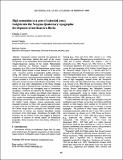Por favor, use este identificador para citar o enlazar a este item:
http://hdl.handle.net/10261/227755COMPARTIR / EXPORTAR:
 SHARE SHARE
 CORE
BASE CORE
BASE
|
|
| Visualizar otros formatos: MARC | Dublin Core | RDF | ORE | MODS | METS | DIDL | DATACITE | |

| Título: | High mountains in a zone of extended crust: Insights into the Neogene-Quaternary topographic development of northeastern Iberia |
Autor: | Lewis, C. J.; Vergés, Jaume CSIC ORCID ; Marzo, M. | Fecha de publicación: | 2000 | Editor: | American Geophysical Union | Citación: | Tectonics 19(1): 86- 102 (2000) | Resumen: | Topographic analysis combined with geological and geophysical observations indicate that much of the present configuration of the northeastern Iberian Peninsula derives from Neogene-Quatemary opening of the western Mediterranean basins following the Pyrenean orogeny. Mountainous topography up to 2000 m lines the Mediterranean coastal margin of Cataluna (Spain) despite a crustal thickness of 22 km at the coast. Geometric analysis of topographic profiles indicates a strong link between topography and extensional tectonics. Trends in maximum, mean and minimum elevations show marked regional increases in a SW-NE direction along the axis of the Ebro basin towards the active Amer-Brugent normal fault. From patterns of local relief, characteristics of the fluvial drainage network, location of drainage divides, and degree of escarpment retreat, we distinguish two overlapping areas of mountainous topography, a southern area related to late Oligocene to middle Miocene rifting and a northern area related to late Miocene to Quaternary rifting. The youthful topography in the northern area likely results from mechanical unloading of the footwall of the Amer-Brugent normal fault. In the southern area (encompassing the Catalan Coastal Ranges), erosion continuously renews topography produced by rifting while causing headward erosion of coastal rivers into the Ebro basin. Elevated topography along the Catalan margin derives principally from flexural isostatic rebound due to tectonic and erosional denudation, causing exhumation of the rifted margin. Nonetheless, the height of the mountains and the thinness of the crust suggest an additional component of dynamic or thermal support of mountainous topography, likely buoyancy forces from density differences in the mantle. Copyright 2000 by the American Geophysical Union. | Versión del editor: | https://doi.org/10.1029/1999TC900056 | URI: | http://hdl.handle.net/10261/227755 | DOI: | 10.1029/1999TC900056 | Identificadores: | doi: 10.1029/1999TC900056 issn: 0278-7407 |
| Aparece en las colecciones: | (Geo3Bcn) Artículos |
Ficheros en este ítem:
| Fichero | Descripción | Tamaño | Formato | |
|---|---|---|---|---|
| Verges_Tectonics_19_86102.pdf | 2,43 MB | Adobe PDF |  Visualizar/Abrir |
CORE Recommender
Page view(s)
113
checked on 23-abr-2024
Download(s)
200
checked on 23-abr-2024
Google ScholarTM
Check
Altmetric
Altmetric
NOTA: Los ítems de Digital.CSIC están protegidos por copyright, con todos los derechos reservados, a menos que se indique lo contrario.
